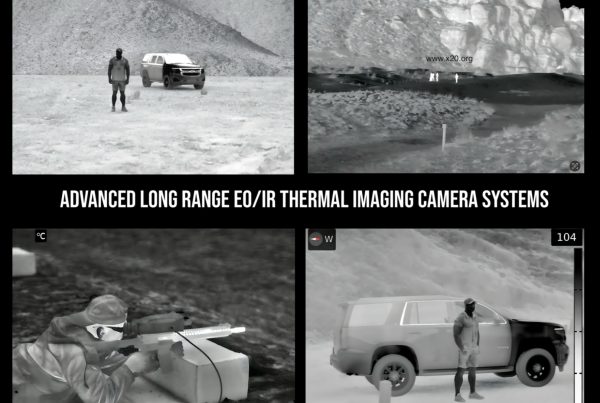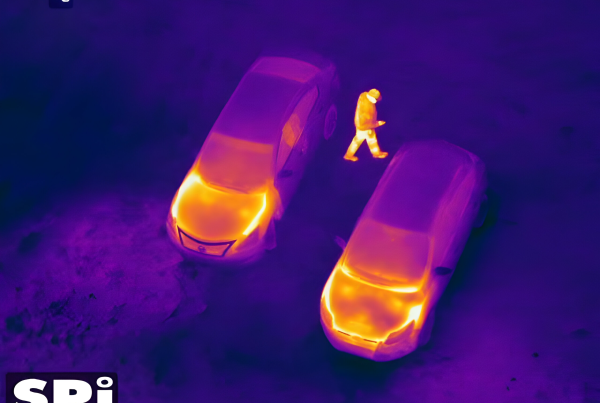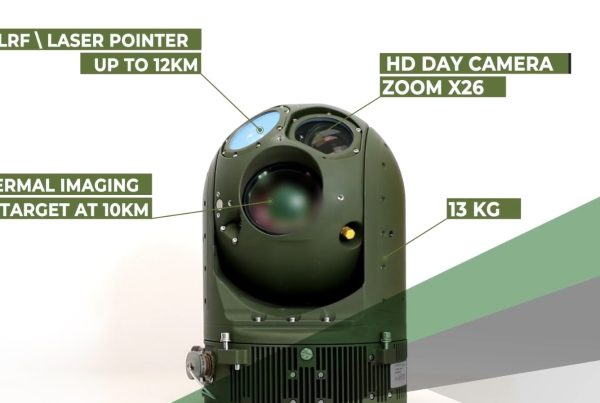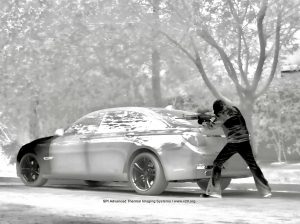
| Long Range Thermal Imaging FLIR EOIR ISR LWIR and MWIR acronyms | 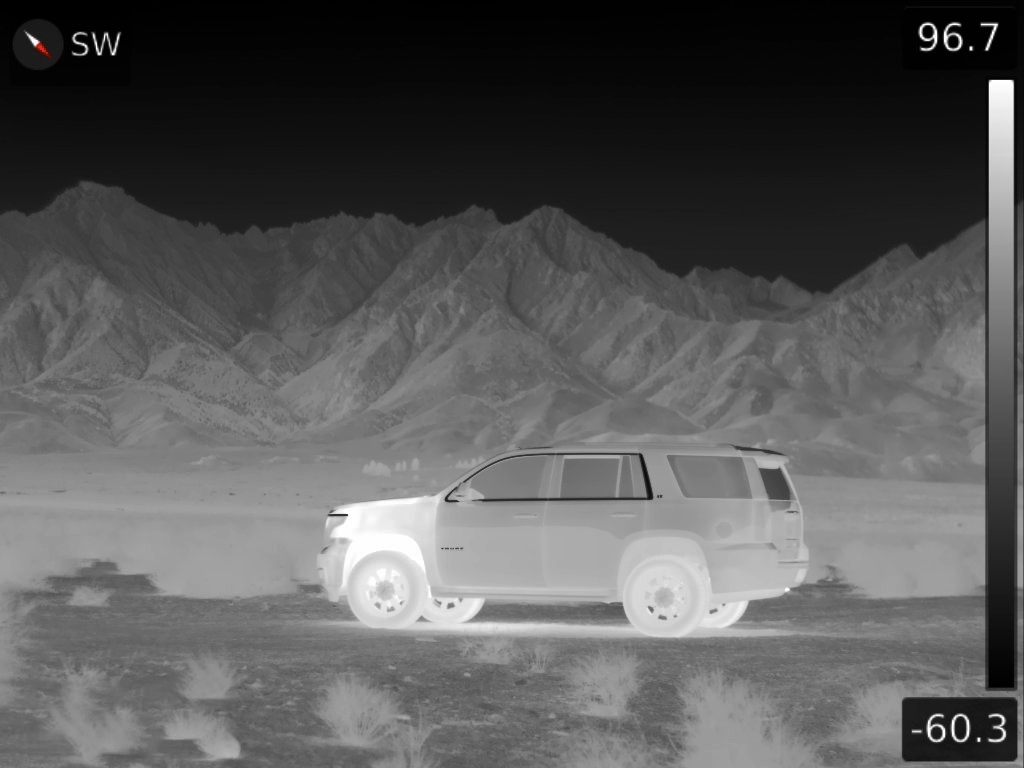  |
||
| Parameter Name | Definition | Description | |
| Optical System | – | The optical system represents the objective optics of an imager. | |
| Aperture Diameter | The diameter of the clear aperture of the collecting optics. | For a compound lens system, this represents an effective aperture. This assumes a circular aperture. | |
| Average Optical Transmission | The percentage of energy transmitted through the optical system over the spectral region of interest. | This can be a band averaged transmission (e.g., 0.8 at 750nm) or a spectrally dependent table within the optic’s transmission band. | |
| Effective Focal Length | The distance between a lens and its focal point. | – | |
| Optics Temperature | The temperature of the optics. | Used for determining the total emitted radiance produced by the optical system. It is assumed the system has an emissivity of one minus the average optical transmission over the spectral range of interest. | |
| Central Obscuration | A circularly shaped aperture obscuring the clear aperture diameter of an imaging system. | – | |
| Staring Array | – | A staring array consists of a two-dimensional grid of photodetectors whereby their output is digitized by the detector mux. These systems do not have scanners. | |
| Horizontal Detector Pitch | The center-to-center distance between samples | Detector pitch may be smaller than the active detector area in cases where super-resolution or dither are modeled as a reduction in detector pitch. | |
| Vertical Detector Pitch | The center-to-center distance between samples | Detector pitch may be smaller than the active detector area in cases where super-resolution or dither are modeled as a reduction in detector pitch. | |
| Horizontal Detector Count | The number of detector elements in the specified dimension. | Other processes such as dither or interpolation may increase or decrease the sample count. | |
| Vertical Detector Count | The number of detector elements in the specified dimension. | Other processes such as dither or interpolation may increase or decrease the sample count. | |
| Frame Rate | Determines the maximum possible integration time available to the detector. | – | |
| Read Time | Used to reduce the total integration time available to the staring array. | The read time is subtracted from the maximum integration time (i.e. calculated from the frame rate) to set the upper limit on the available integration time. | |
| Detector | – | Represents a generic photodetector. The operational specifics of the detector are represented in as simple terms as possible. | |
| Horizontal Detector Dimension | The integrating or active area of the detector. | This value is used in calculating the MTF of the detector element and determining how much signal is collected by each detector element | |
| Vertical Detector Dimension | The integrating or active area of the detector. | This value is used in calculating the MTF of the detector element and determining how much signal is collected by each detector element | |
| Desired Well Fill | Specifies the percentage of the full well capacity achieved during typical operation. | This value is typically set to 50% so as not to saturate the image. | |
| Well Capacity | The maximum number of electrons an individual detector can store before saturating. | Typically this value will be designed to accommodate the photon flux for a particular pixel size and wavelength range of interest. | |
| Dark Current Density | The current that flows through photodetectors when no photons are entering the device. | The dark current input can be specified spatially or temporally. The units selected will determine any additional spatial or temporal scaling performed by the model. | |
| Total Downstream Noise | Represents the noise floor of the imaging system, excluding dark current noise. | Downstream noise is the combination of read noise, amplifier noise, clock noise, etc. Downstream noise typically becomes the dominant noise source when the system is light starved or running at shorter integration times. | |
| Spectral Quantum Efficiency | The per wavelength quantum efficiency. | – | |
| Shield | – | Represents both cold and warm shields in an optical system. The shield component is a requisite part of any system model representing a cooled camera. | |
| Average Shield Transmission | The percentage of energy transmitted through the optical system over the spectral region of interest. | The “Optical System” component utilizes a band averaged transmission to represent this term. | |
| Reflected Temperature | Determines the total reflected extraneous signal generated by an optical component. | – | |
| Shield Emissivity | Can be varied to model the effects of increasing the reflectivity of the warm shield to reduce the emissive portion of the signal. | A shield emissivity of less than one implies that the shield is reflecting some other source of extraneous signal. It assumes that the shield produces an emitted spectral radiance at the specified shield temperature and emissivity, and reflects a second spectral quantity at one minus the emissivity at the specified ‘reflected temperature’. The shield emissivity input is most typically used to model cases where a warm shield is used to implement a dual f-number system, where the shield is reflecting the exterior of the dewar. | |
| Shield Temperature | Determines the total extraneous signal introduced by this component. | – | |
| Uncooled Detector | – | Represents a generic microbolometer. The operational specifics of the detector are represented in as simple terms as possible. | |
| Cuton Wavelength | The minimum spectral response of the device. | Note that bolometers will typically be sensitive to a very wide range of wavelengths. | |
| Cutoff Wavelength | The maximum spectral response of the device. | Note that bolometers will typically be sensitive to a very wide range of wavelengths. | |
| Measured NETD | Used to determine the total noise in the system. | Typical values for NETD range from 5 to 500 milliKelvin. | |
| Sigma VH | The total horizontal/vertical fixed pattern noise term. | – | |
| Sigma V | The total vertical fixed pattern noise term. | – | |
| Sigma H | The total horizontal fixed pattern noise term. | – | |
| Measured F-Number | Used to scale the NETD input from a measurement (reference) configuration to a value which can be used to determine the noise level in the system under evaluation. | If the measurement f-number for the measured value is the same as the system under evaluation, the value may be set to 0.0 which will cause the model to use the f-number of the system under evaluation to scale NETD. | |
| Measurement Transmission | The measurement transmission is used to scale the NETD input from a measurement (reference) configuration to a value which can be used to determine the noise level in the system under evaluation. | S/A | |
| Measurement Frame Rate | The measurement frame rate is used to scale the NETD input from a measurement (reference) configuration to a value which can be used to determine the noise level in the system under evaluation. | S/A | |
| Time Constant | The time constant of the microbolometer. | The time constant is used to evaluate the effects of motion blur on the final image quality. | |
| Infrared imaging systems encompass a wide variety of technologies and applications. Technologies range from new infrared detector materials and devices to new optical materials and methods. The applications are primarily military, but security and commercial applications continue to grow rapidly as infrared components become more affordable.
The military applications can be grouped in typical areas of lethality, survivability, and mobility. Lethality applications include targeting, intelligence-surveillance-reconnaissance (ISR), and persistent-ISR or PISR. Target involved discrimination of targets at long range, SR involves large area imaging, and persistent ISR involves tracking people, vehicles, and maritime craft. Survivability applications comprise infrared countermeasures (IRCM) which is the act of defeating a ground-to-air missile, infrared search and track (IRST) which is long range aircraft/drone detection, and hostile fire indication (HFI) which is small arms detection. Finally, mobility applications are both daytime and night pilotage, driving, and operations in degraded visual environments (DVE). Situation awareness (SA) is the collective state of all sensor inputs and the tools for understanding the current and past status of operations. All of the applications described above require high performance systems in a competitive environment that naturally requires new and innovative technologies to be developed on a continuous basis. These technologies range from optics to detectors to computational processes (signal and image processing) to new displays. Fundamental questions involve the best bands to operate. The middle figure shows both a tank and a boat in four different infrared bands. The operation performance in each band depends on a huge number of variables to include system component parameters as well as external quantities such as climate, source radiometry, atmospheric transmission, path radiance, turbulence, etc. |
|||
| Newer component technologies are making significant contributions to infrared system design and performance. The areas of infrared detectors have seen quantum efficiency in type II superlattice structures increase in the LWIR, high operating temperature (HOT) in the midwave of 150K, and digital readout integrated circuits (ROICS) have allowed much deeper charge well capacity in focal planes resulting in higher signal to noise ratio (SNR).
There has always been a rivalry between MWIR and LWIR bands in infrared systems, especially for targeting applications that occur on fighter jets, attack helicopters, tanks, ships, and many other platforms. In another project the team is currently comparing MWIR and LWIR performance over many different conditions. One particular comparison involves the scattering of MWR versus LWIR in aerosol conditions that degrades target and background contrasts. The group is also studying the optimization of IRST staring systems in support of Air Force Research Laboratory for application to aircraft and unmanned aerial vehicle detection. Another project aims at investigating a new exciting detector material and detector structures in PbSe. PbSe provides the possibility of the first MWIR high performance detector without having to be cryogenically cooled. |
|||

